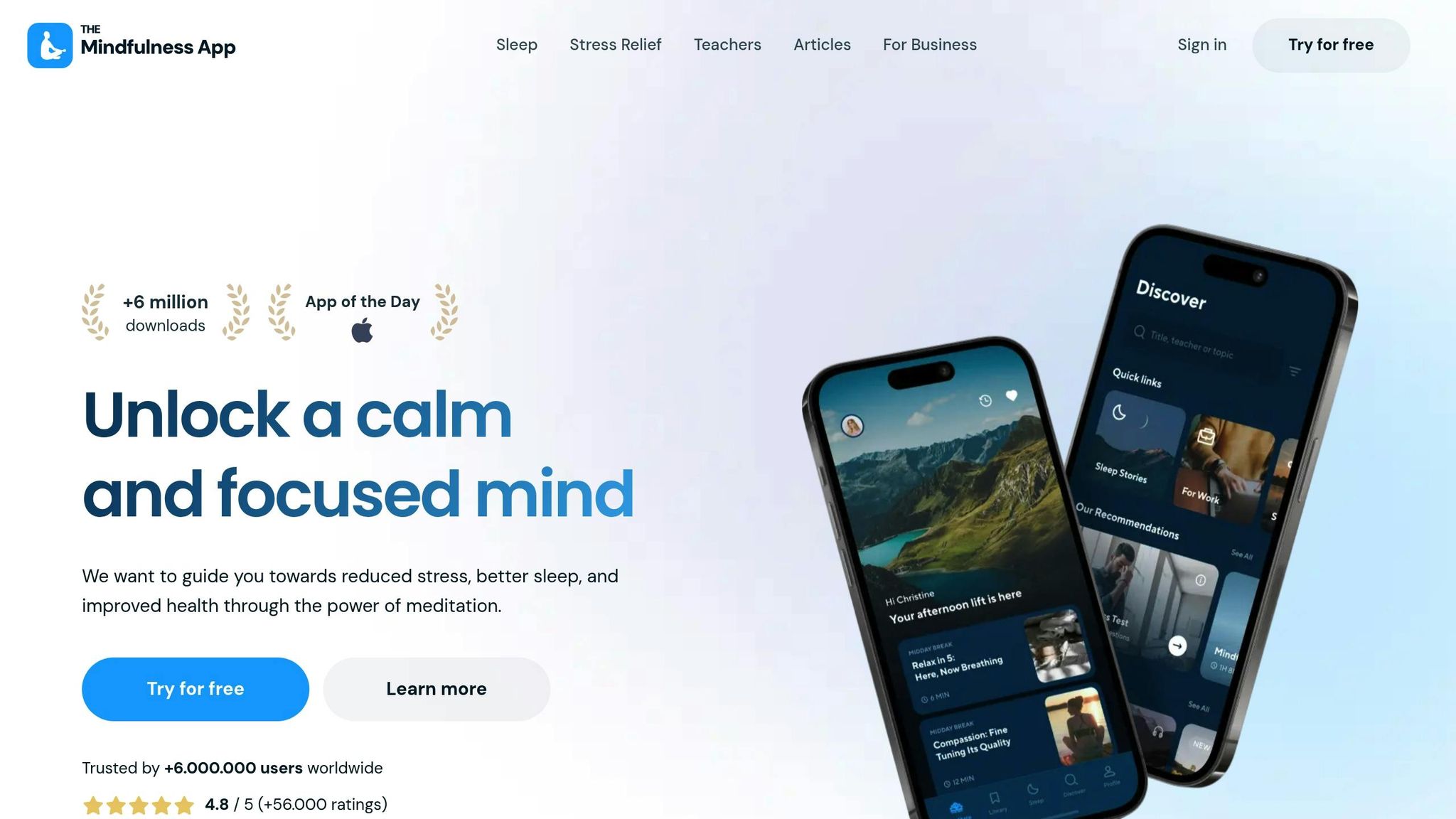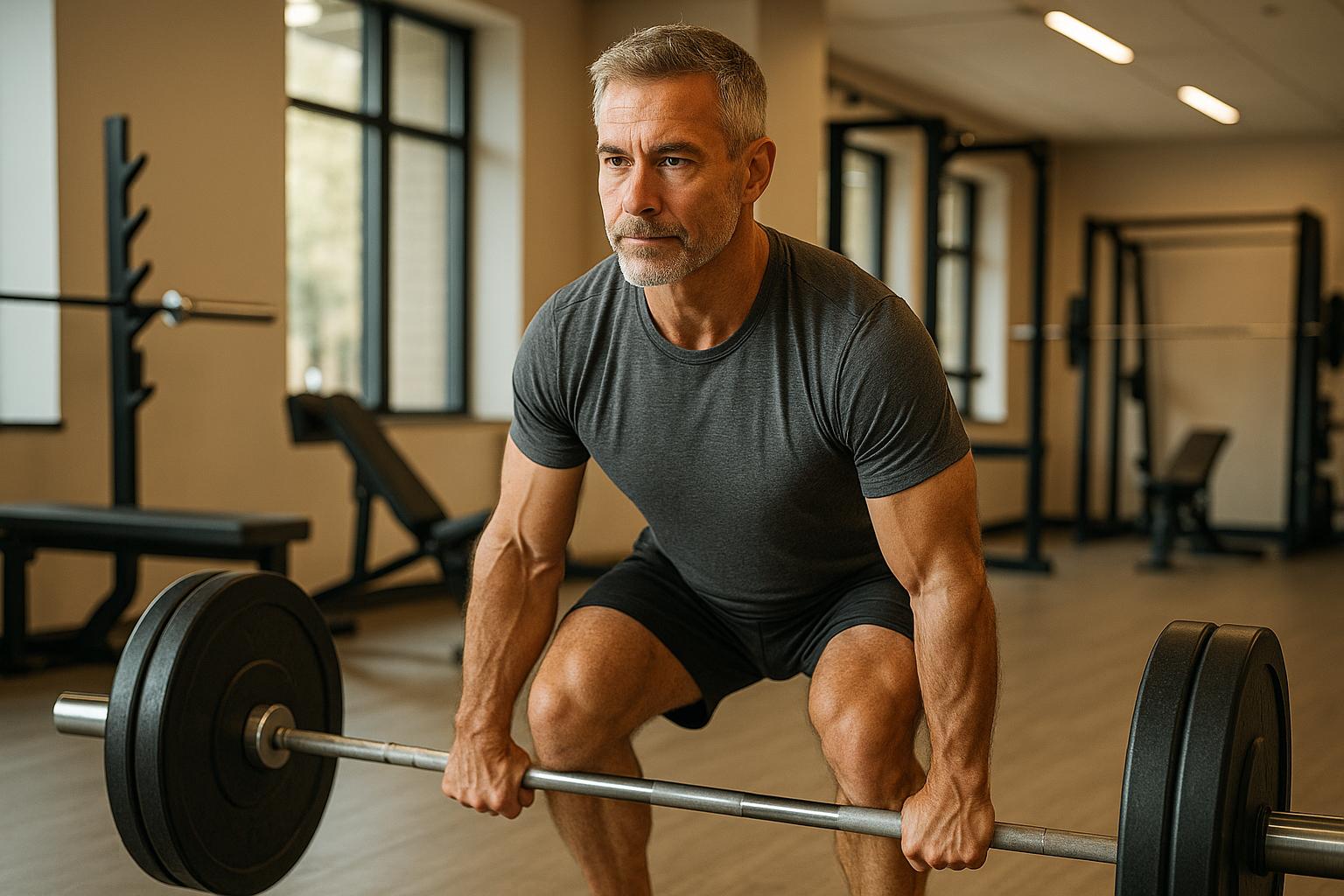Want to age stronger, healthier, and sharper? Combining testosterone optimization with heavy lifting can be your go-to strategy for longevity. Testosterone supports muscle mass, bone strength, and cognitive health - key factors for aging well. Heavy lifting not only boosts testosterone but also preserves muscle, strengthens bones, and enhances metabolic health.
Key Points:
- Testosterone naturally declines with age but can be improved through resistance training, better sleep, and stress management.
- Heavy lifting is powerful for increasing testosterone, with compound exercises like squats and deadlifts offering the best results.
- Lifestyle tweaks matter: Prioritize sleep, eat protein-rich meals, and manage stress to support hormone balance.
- Track progress using apps like The Do App for workouts, Reflectly for stress, and HealthView for overall health metrics.
Start with a physical exam, plan your workouts, and make small, consistent changes to your routine. Strength training combined with balanced testosterone levels can help you stay fit, independent, and energized as you age.
How to Exercise for Strength Gains & Hormone Optimization | Dr. Duncan French
Proven Methods to Boost Testosterone Naturally
If you're looking to naturally boost testosterone, resistance training is one of the most effective strategies. Testosterone plays a key role in overall health and longevity, and research has shown that specific training methods can lead to noticeable and lasting improvements.
Heavy Weight Training for Higher Testosterone
Resistance training is a proven way to elevate testosterone levels. In fact, just a 30-minute weightlifting session can increase testosterone by 21.6%. This immediate surge, combined with the long-term benefits of regular training, makes weightlifting an essential part of any testosterone-boosting plan.
For the best results, focus on compound exercises like squats, deadlifts, bench presses, and barbell rows. These movements engage multiple muscle groups and strongly stimulate testosterone production. Leg-focused exercises, in particular, have shown to be especially effective. Studies reveal that individuals who included lower-body exercises in their routines experienced greater testosterone increases compared to those who only worked their upper body.
To maximize testosterone production, aim to lift heavy weights using 6–8 reps per set, with 1–2 minutes of rest between sets. Consistency is key - research indicates that men who performed resistance training three times per week for four weeks saw not only immediate testosterone spikes after workouts but also sustained increases over time.
However, balance is important. Avoid overdoing cardio, as excessive endurance training can elevate cortisol levels, which may counteract testosterone gains. By fine-tuning your workout routine, you can enjoy both the short-term hormonal boosts and the long-term health benefits of optimized testosterone levels.
How Heavy Lifting Extends Male Lifespan
Heavy lifting doesn’t just build stronger muscles - it plays a key role in laying the foundation for a longer, healthier life. By preserving muscle mass and bone density through strength training, men can enjoy better health and resilience as they age.
As men get older, they naturally lose muscle mass - a process called sarcopenia. This decline in muscle strength increases the risk of falls, fractures, and other age-related health issues.
Best Strength Training Methods for Longevity
To maximize the benefits of strength training, focus on progressive overload using compound movements like deadlifts, squats, and overhead presses. These exercises not only target multiple muscle groups but also mimic real-life activities, making them incredibly effective. Balancing consistent training with proper rest ensures that muscles are challenged without leading to burnout or fatigue.
Strength Training by Age and Experience Level
Your training program should evolve with your age and experience to ensure safety and effectiveness.
- 20s and 30s: Men in this age range can handle higher training volumes, making split routines - where different muscle groups are targeted on different days - an excellent choice. Shorter recovery times are generally sufficient.
- 40s and 50s: Full-body routines performed several times a week work well for this group. These routines allow for adequate recovery while ensuring all muscle groups are activated. Dynamic warm-ups become especially important to prepare the body for exercise and reduce the risk of injury.
- 60 and older: Focus shifts to functional strength and mobility. Lighter weights with slightly higher repetitions help reduce joint stress while keeping muscles active. Beginners at any age should start with bodyweight exercises or light resistance to allow their connective tissues to adapt gradually.
Health Benefits Beyond Testosterone from Heavy Lifting
The benefits of heavy lifting go far beyond boosting testosterone levels. For one, weight-bearing exercises stimulate bone growth, lowering the risk of osteoporosis and helping maintain independence later in life. Strength training also supports cardiovascular health by improving heart rate variability, lowering resting blood pressure, and encouraging healthier cholesterol levels.
Adding muscle mass has a ripple effect on overall health. It increases resting energy expenditure, aiding in weight management and supporting balanced insulin sensitivity. On the mental health front, strength training has been shown to reduce stress, anxiety, and depressive symptoms, while also improving cognitive function.
Better yet, regular strength training can enhance sleep quality, leading to more restorative rest and better energy levels throughout the day. Maintaining strength as you age also ensures functional independence, allowing you to confidently and safely handle everyday tasks.
sbb-itb-72d195f
Building Lasting Habits with Digital Tools
Maintaining testosterone levels and achieving fitness goals isn’t just about occasional effort - it’s about building daily habits. Digital tools can help make these habits stick by offering visual feedback, timely reminders, and insights into patterns. When used effectively, these tools turn good intentions into measurable results by providing structure, accountability, and a clear sense of progress. Below, we’ll explore apps that can help you track progress, manage stress, and monitor health - key elements for boosting testosterone and supporting long-term wellness.
Track Your Progress with The Do App

The Do App is a powerful tool for tracking and sustaining habits that support testosterone levels. With its color-coded streaks, you can easily monitor routines like workouts, supplement intake, and sleep patterns. Instead of relying on memory or manual tracking, the app provides a visual representation of your consistency, which can be incredibly motivating.
For instance, you can set habits such as completing regular strength training, taking vitamin D supplements, getting 7–8 hours of sleep, or adding protein to every meal. Watching a 30-day streak of consistent workouts grow can serve as a strong motivator to keep going.
Over time, the app’s visual trends feature can reveal connections between your habits and how you feel. You might notice that skipping strength training affects your energy levels or that reducing screen time before bed improves your sleep quality. These insights help you fine-tune your routine for better results.
Manage Stress with The Mindfulness App and Reflectly

Stress is a known disruptor of testosterone production, primarily due to its impact on cortisol levels. Apps like The Mindfulness App and Reflectly can help you manage stress and protect your hormone balance. Guided meditations on The Mindfulness App are designed to lower cortisol and improve sleep quality, while Reflectly uses AI-driven journaling to help you identify and address stress triggers.
Reflectly offers a structured way to process daily challenges. By journaling, you can uncover patterns in your stress - whether they stem from work, relationships, or other areas of life. This awareness can help you take proactive steps to reduce cortisol levels and support your overall recovery.
When combined, meditation and journaling create a solid foundation for stress management. Many users report feeling more energized, motivated, and better able to recover from workouts when they consistently address their mental and emotional well-being.
Monitor Your Health Data with HealthView

HealthView is an app that turns the health data from your iPhone and Apple Watch into actionable insights. By syncing with Apple Health, it consolidates key metrics like sleep duration, heart rate variability, daily steps, and workout frequency into a single, easy-to-read dashboard.
This streamlined approach allows you to focus on the metrics that matter most for your testosterone and longevity goals. You can set personalized targets, such as completing a certain number of strength training sessions each week, maintaining a healthy resting heart rate, or ensuring consistent, high-quality sleep.
Your Complete Male Longevity Plan
Strength training and optimizing testosterone levels form the backbone of a solid strategy for healthy aging. By combining exercise, nutrition, recovery, and tech-based tracking, you can create a sustainable plan for long-term health.
Main Strategies for Testosterone and Longevity
Compound lifts are key to supporting testosterone production and preserving muscle mass. Make strength training a regular part of your routine, focusing on progressive overload to keep challenging your muscles.
Nutrition plays a major role. Aim for a diet rich in protein, healthy fats, and essential nutrients like zinc, magnesium, and vitamin D, all of which contribute to hormone balance and overall health.
Prioritize sleep and manage stress - both are critical for maintaining optimal testosterone levels. Poor sleep and chronic stress can increase cortisol, which may disrupt hormone production. Stick to a consistent sleep schedule, ensuring you get enough rest, and incorporate stress-relief activities such as meditation, deep breathing, or journaling into your daily life.
Leverage digital tools to stay consistent and track your progress. Apps like The Do App help you stick to workout routines and daily habits, while HealthView integrates with your iPhone and Apple Watch to monitor key health metrics. For stress management, apps like The Mindfulness App and Reflectly provide guided meditation and journaling options.
Long-Term Results from the Male Longevity Approach
By sticking to this comprehensive plan, you can experience noticeable improvements in your overall health. Regular strength training not only boosts physical strength but also enhances functional movement, lowers injury risk, and helps maintain independence as you age.
Balanced hormone levels often lead to increased energy and sharper mental focus. Many men find that combining consistent workouts with proper recovery supports better mood and cognitive performance over time.
Improved body composition is another significant benefit. Building muscle and reducing body fat can enhance metabolic health, lowering the risk of age-related issues like diabetes and heart disease. Additionally, heavy lifting has been linked to better heart health, stronger bones, and improved insulin sensitivity, all of which contribute to healthier aging.
How to Start Your Longevity Plan Today
Get a physical exam to establish a baseline for testosterone levels, blood pressure, and other critical health markers. This will help you track your progress effectively.
Choose exercises that match your fitness level. If you're new to lifting, start with bodyweight exercises and lighter weights to focus on proper form. More experienced lifters can dive into heavier compound movements, gradually increasing the intensity.
Make small, manageable changes to your diet. Instead of overhauling everything at once, start with one improvement each week. For example, add a quality protein source to every meal, then work on incorporating healthy fats and timing your meals around workouts.
Set up digital tools in your first week. Use apps like The Do App and HealthView to monitor your workouts, sleep patterns, and supplements. These tools become even more valuable as you gather data over time.
Establish a consistent sleep routine and create an environment that promotes quality rest. Keep your bedroom cool, dark, and free from electronic distractions to improve sleep quality.
Once you've got these basics in place, take action immediately. Plan your first month's workouts and treat them like non-negotiable appointments. Building consistency early on is crucial for creating momentum and setting yourself up for long-term success.
FAQs
How does heavy lifting help boost testosterone and support men's longevity?
The Impact of Heavy Lifting on Testosterone and Longevity
Heavy lifting isn’t just about building strength - it’s a key factor in boosting testosterone levels and promoting long-term health in men. After a strength training session, testosterone production gets a temporary spike. This uptick supports muscle development, fat reduction, and improved energy levels. When done consistently, resistance training helps maintain hormonal balance, supports a healthy metabolism, and fights off the muscle loss that comes with aging.
Studies also highlight a strong connection between regular weightlifting and a longer life. In fact, weightlifting can lower the risk of premature death by as much as 22%. With such benefits, heavy lifting stands out as a powerful way to stay strong, energized, and age more gracefully.
What are some simple lifestyle changes to naturally boost testosterone levels beyond heavy lifting?
To naturally support testosterone levels, make some smart lifestyle choices that promote hormonal balance. Start by eating a well-rounded diet rich in healthy fats (think avocados and nuts), lean proteins, and complex carbs. These nutrients play a big role in maintaining hormone health.
Getting enough quality sleep - ideally 7 to 9 hours a night - is essential, as proper rest helps your body produce hormones efficiently. Stress management is another key factor. Chronic stress can lead to lower testosterone, so try incorporating mindfulness practices, meditation, or enjoyable hobbies into your routine.
It’s also wise to limit alcohol and steer clear of smoking, as both can interfere with hormone levels. And don’t forget to stay active! Pair regular strength training with cardiovascular exercises like brisk walking or cycling to boost energy and overall well-being.
How can apps like The Do App and HealthView help with testosterone optimization and improving longevity?
Apps such as The Do App and HealthView are becoming essential tools for those looking to optimize testosterone levels and improve overall health. These apps offer real-time health tracking and tailored insights, allowing users to keep an eye on key factors like testosterone levels, sleep patterns, and stress management.
With features like detailed progress tracking and practical recommendations, these tools simplify staying on top of fitness goals, nutrition, and lifestyle adjustments. By leveraging this data, users can make informed decisions to enhance their energy, vitality, and long-term well-being.
Related posts
- Zone 2 Cardio + Strength Training: The Only Exercise Combo You Need for Longevity
- NAD+ + Senolytics + Rapamycin: The Pharmaceutical Longevity Stack Explained
- Resistance Training + Protein Timing: The Muscle Longevity Stack for Over 50
- Morning HIIT + Evening Yoga: The Perfect Day Longevity Exercise Stack
